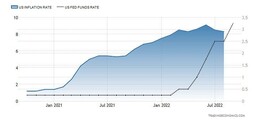October 12, 2022: Downward trendFollowing the September 22, 2022 report titled "Bearish warning signs build", those cautionary signals of the inverted US yield curve and mounting market weakness continue to unfold. The Fed's relentless attack on record inflationary pressures by rapidly increasing interest rates has caused the yield curve to invert. The US yield curve inverted in mid-July and has remained in this concerning position for about 12 weeks (Chart 1). The importance of this action is its predictive record of market corrections/bear declines and recessions. Since the 1960s, every inverted US yield curve that has lasted longer than 6 weeks has produced a sharp market correction and recession. Inflationary pressure is clearly the cause of the rapid rise in rates. The US inflation rate topped 9% in Q2, the highest level in 40 years. Though the inflation rate appears to have peaked and now easing slightly, the Fed's response is to continue to drive rates higher (Chart 2). The latest number for the US Core Inflation Rate ticked up in August to 6.3%, the highest level since March. The market forecast was 6.1%. This unexpected bounce will reinforce the Fed's position for another jumbo 75 bps rate increase at the November 1 meeting. The resulting action of a prolonged inverted yield curve plus additional upward pressure on short-term rates, is driving the markets lower (Chart 3). Currently, all the major equity markets are feeling the heat from record inflationary pressures. The NYSE is the first US market to break key support. The Dow and S&P 500 are expected to follow. Bottom line: The unprecedented rise in inflationary pressures has driven the Fed into a pattern of aggressive interest rate increases. This action has resulted in inverting the yield curve. The expected plan by the FOMC to raise interest rates again at the November 1 meeting will only add more downward pressure on stocks. It is important to remember, that every US inverted yield curve since the 1960s that has lasted for more than 6 weeks, has produced a sharp market correction and a recession. There is nothing dissimilar in the actions of the markets that suggests that this time things will be any different. |

|
|
|
|
D.W. Dony and Associates
4973 Old West Saanich Rd.
Victoria, BC
V9E 2B2
|
.jpg)

.jpg)